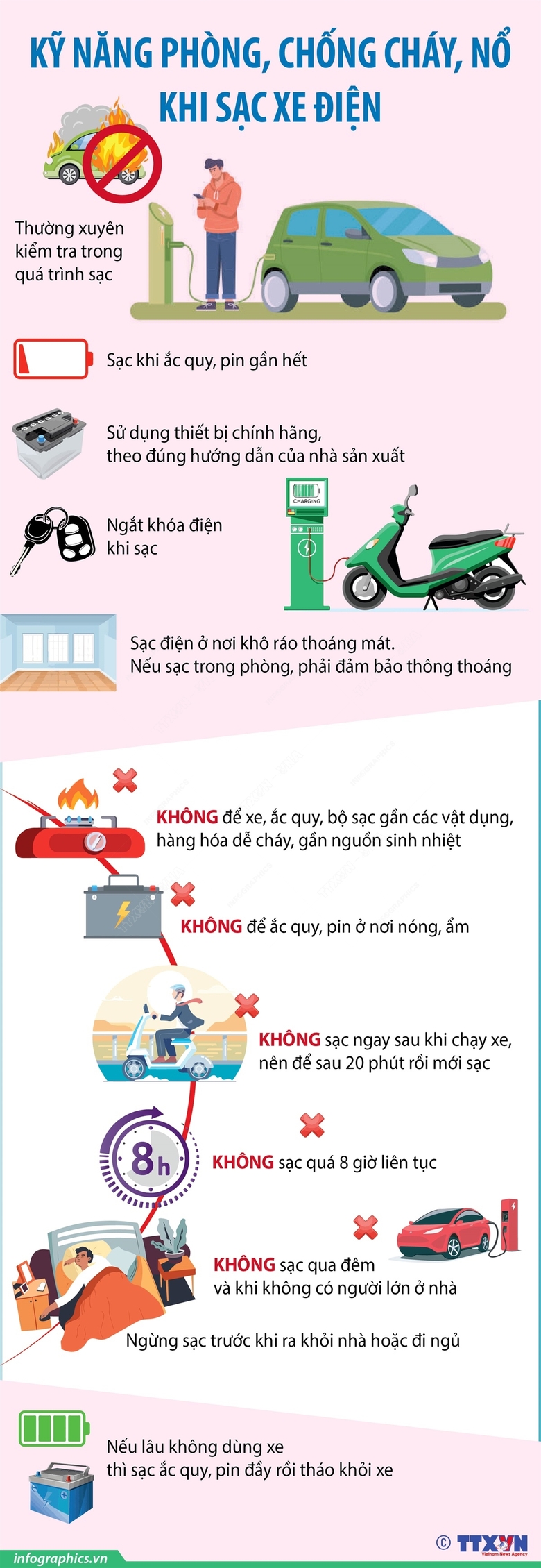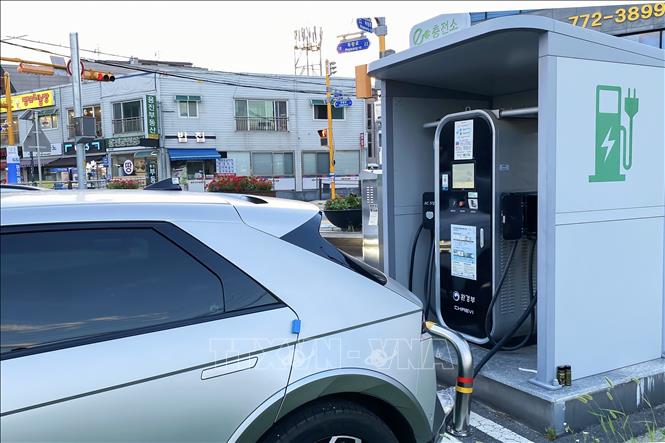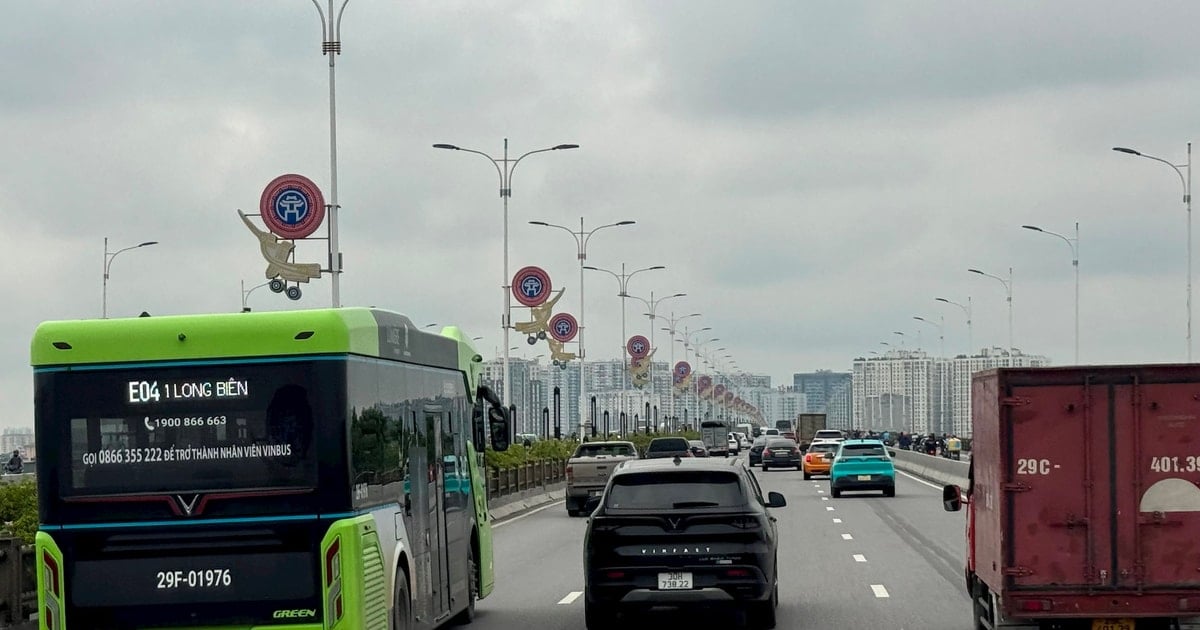
Specifically, using poor quality batteries, batteries of unknown origin or repaired, changing the manufacturer's technical specifications; installing additional or replacing power consuming equipment compared to the design (installing alarm devices, horns, lights with increased capacity compared to the manufacturer's design...) or overloading will affect the quality, reduce the life of the battery, when charging will cause the battery to swell and possibly explode.
Another cause, according to Department C07, is that the converter from alternating current to direct current and vice versa is also the cause of fire and explosion in electric vehicles, due to the welds and connectors of the components not being well insulated, it can cause electric discharge or short circuit, leading to fire.
Replacing, repairing, or using a charger that does not meet the manufacturer's specifications, does not guarantee quality, or is not synchronized with the vehicle's battery when charging can cause an electrical short circuit or battery explosion.
Regarding improper charging, according to Department C07, charging for too long, charging frequency is too high; charging in high temperature conditions; charging immediately after use, the battery has not had time to cool down naturally; charging near heat sources, fire-generating or heat-generating equipment or near or above flammable or explosive objects and goods, while the battery itself radiates heat without being able to release heat is also the cause of battery explosion and fire.
When charging without disconnecting the power source (charging and discharging at the same time), the alarm device will consume power, causing the control function of the sensor charger to be incorrect, the control process at the conversion line is not possible, causing the charging phenomenon to not switch to the maintenance charging current (no flashing light), thereby losing control in the charging control, possibly causing damage, short circuit of the charger. At the same time, increasing the battery temperature, the battery can cause internal short circuit (battery cell short circuit) or external short circuit (battery connected to power electronic equipment, engine and other accessories short circuit) will cause the vehicle to catch fire.
According to Department C07, some cases of external impact also lead to short circuits and fires: The charging socket is wet, charging in a place that is not well-ventilated so that the device can dissipate heat; the electrical wires are not connected to technical requirements or used for a long time or are impacted, or bitten by rats, causing loss of insulation, causing discharge and short circuits.
To prevent the risk of fire and explosion when using electric vehicles, the Fire Prevention, Fire Fighting and Rescue Police Department recommends the following: Choose and use quality electric vehicles that have been inspected by competent management agencies according to regulations; strictly follow the manufacturer's instructions.
Charge the battery according to the manufacturer's instructions and recommendations to ensure durability and safety during use; do not charge the vehicle when detecting a fault in the charging device or vehicle; when the battery shows signs of swelling, cracking, etc., replace the battery with a new one.
At the same time, Department C07 notes: Charge the battery when it is almost empty, use a suitable power source (according to the manufacturer's recommended voltage level) and stable; after use, wait for the battery to cool for about 20 minutes before starting to charge, do not charge immediately after driving, do not charge for more than 8 hours continuously, when charging, turn off the power source, otherwise it will affect the charging process... If the vehicle is not used for a long time, charge the battery until it is full and then remove it from the vehicle; do not leave the battery in hot, humid areas; store the battery in a high, cool place...
Charge in a cool, dry place. When charging indoors, avoid closed places and ensure good ventilation in temperatures between 0℃ and 35℃. If not, take measures to insulate or reduce heat. When charging, do not leave the vehicle, battery, charger on or near flammable or explosive objects or goods, near fire sources, heat sources, or heat-generating devices.
During the charging process, you must regularly check to promptly detect and handle problems immediately; stop charging before leaving the house or going to bed, absolutely do not charge overnight and when there are no adults at home.
Department C07 emphasizes that it is not allowed to arbitrarily adjust the technical parameters of vehicles and equipment that are different from the technical requirements of the vehicle; when replacing equipment, components, batteries, batteries, chargers, etc., it is necessary to choose the right type of battery, compatible with the specified parameters of the charger, motor and controller, do not use types of unknown origin; do not arbitrarily change the vehicle structure, do not install additional accessories or equipment that affect the vehicle's wiring system and power source (incompatible equipment, power source differences can cause batteries and batteries to explode). Carry out inspection and maintenance according to the manufacturer's regulations.
For electric cars, according to Department C07, charge at licensed electric car charging stations according to regulations (at gas stations, rest stops, in houses and buildings...) or use a home charger that ensures fire safety according to the manufacturer's instructions.
Electric charging stations must maintain requirements on fire prevention solutions, preventing fire from spreading to surrounding areas (gas stations, parking areas...) and be equipped with fire prevention and fighting equipment according to regulations; have a plan to handle fire and explosion situations in the electric charging area.
Regularly check, maintain and service equipment, electrical systems, fire prevention and fighting equipment at the charging station to promptly detect and replace damaged equipment during operation.
According to Department C07, the use of internal combustion engine vehicles (using gasoline fuel) has significantly affected environmental pollution and the trend of "greening" vehicles is an inevitable trend that can reduce the burden on the environment and public health. Electric vehicle technology is becoming an inevitable trend and electric vehicles are currently very popular in developed countries such as Germany, Norway, England, France, the Netherlands, China, India, etc.
In the face of this shift, Vietnam is no exception, the rate of people using electric vehicles (electric bicycles, electric motorbikes...) is gradually increasing across the country, especially in large cities such as Hanoi, Ho Chi Minh City and Da Nang. Currently, electric vehicles use many types of batteries (lead acid batteries, dry batteries, lead acid batteries, nickel metal hydride batteries, lithium ion batteries, nickel - cadmium batteries), the most common type is lithium ion batteries; charging batteries follows the principle: 220V AC power is converted to DC through a power converter and charges the battery.
In addition to the conveniences of this type of vehicle, there are many issues of concern, including the risk of fire and explosion from the vehicle's electrical system. In recent times, there have been many electric vehicle fires in the world and in Vietnam, causing serious damage to people and property, typically: The electric vehicle fire in New York City in April 2023 killed 2 people and in June 2023 killed 4 people; the electric vehicle fire at a house in Xuan Phu neighborhood, Trung Son ward, Sam Son city, Thanh Hoa province occurred on July 12, 2023, killing 2 people...
Source





![[Photo] Closing of the 11th Conference of the 13th Central Committee of the Communist Party of Vietnam](https://vstatic.vietnam.vn/vietnam/resource/IMAGE/2025/4/12/114b57fe6e9b4814a5ddfacf6dfe5b7f)





























![[Photo] Overcoming all difficulties, speeding up construction progress of Hoa Binh Hydropower Plant Expansion Project](https://vstatic.vietnam.vn/vietnam/resource/IMAGE/2025/4/12/bff04b551e98484c84d74c8faa3526e0)



























































Comment (0)